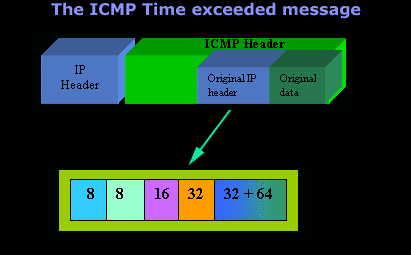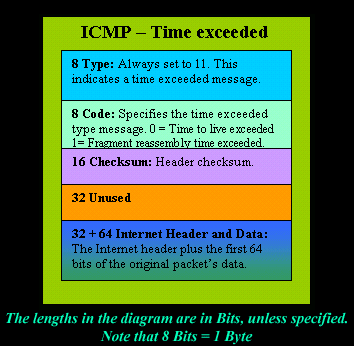ICMP - Time
Exceeded Message
Introduction
The
ICMP - Time exceeded
message is one which is usually created by
gateways or routers. In order to fully
understand this ICMP message, you must be
familiar with the IP header within a packet. If
you like you can go to the Download - Documents
section and grab a copy of the
TCP/IP in a Ethernet II
Frame file which breaks down the IP
header nicely.
When
looking at an IP header, you will see the
TTL and
Fragment Flag
fields which play a big part in how this ICMP
message works. Please make sure you check them
out before attempting to continue !
The
ICMP - Time exceeded
message is generated when the gateway processing
the datagram (or packet, depending on how you
look at it) finds the Time
To Live field (this field is in the IP
header of all packets) is equal to zero and
therefore must be discarded. The same gateway
may also notify the source host via the time
exceeded message.
The
term 'fragment'
means to 'cut to pieces'. When the data is too
large to fit into one packet, it is cut into
smaller pieces and sent to the destination. On
the other end, the destination host will receive
the fragmented pieces and put them back together
to create the original large data packet which
was fragmented at
the source.
Analysis
Let's have a look at the structure of an
ICMP - Time exceeded
message:


If a
host reassembling a fragmented datagram (or
packet) cannot complete the reassembly due to
missing fragments within its time limit it
discards the datagram and it may send an
ICMP - time exceeded
message.
If
fragment zero is not available then no
ICMP - time exceeded
message is needed to be sent at all.
Code 0 may be
received from a gateway and
Code 1 from a host.
So,
summing it up, an ICMP -
Time exceeded message can be generated
because the Time to live
field in the IP header has reached a
value of zero (0)
or because a host reassembling a fragmented
datagram cannot complete the reassembly within
its time limit because there are missing
fragments (Fragment
reassembly time exceeded the allocated
time).
